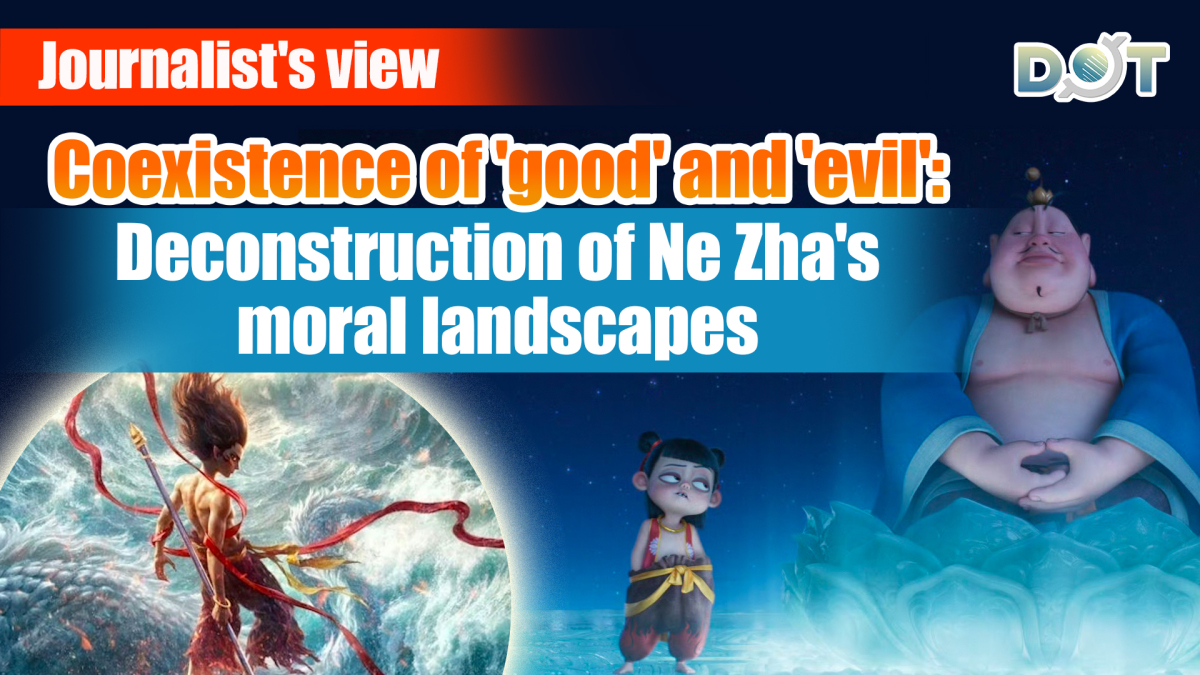
By Liu Yu
Ne Zha 2 is undoubtedly a milestone in Chinese animated films. This sequel not only continues the visual feast of special effects from the first film but also delivers an unprecedented auditory experience. The film is rich in sci-fi elements, with a fast-paced rhythm that dazzles viewers with true audiovisual celebration.
The use of ink-wash painting techniques complements the grand backgrounds, creating a breathtaking atmosphere. The spectacular scenes exude a strong sense of technology, immersing viewers in a dreamy fairyland. The character portrayals are intricate and vivid, making it feel as if they might step out of the screen to engage with the audience at any moment.
The film's respect for dialects highlights regional characteristics, while the blend of literary and colloquial dialogue preserves the charm of traditional culture. The clever integration of classical poetry and literary language enriches the cultural depth. Additionally, the use of puns and internet memes makes the story more lively and relatable, keeping pace with contemporary trends and providing plenty of laughs.
Attention to detail is meticulous, with realistic portrayals of moving shadows, exquisite dragon scales, and clothes billowing in the wind. Each frame is like a work of art-stunning and intricate, perfectly mirroring reality. This is not just an animated film; it's a visual feast merging culture and technology, showcasing the limitless potential and future of Chinese animation!
In Ne Zha 2, the conflict of identity among characters reflects that "good" and "evil" are not merely traditional binary concepts, but rather a blurred perception. In the film, "immortals" and "demons" are not absolute categories; the choices and actions of characters are filled with complexity. This is particularly evident in the portrayal of dragons. In traditional Chinese culture, dragons are often seen as symbols of authority, goodness, and justice, yet in the film, they exhibit elements of treachery and betrayal, challenging viewers' perceptions and hinting at the choice of rule-makers.
Similarly, the elder of the Yuxu Palace appears kind and benevolent, surrounded by positive Taoist elements like celestial peaches and a pristine heavenly palace, yet this does not mean he represents "good" entirely. Judgments of Ne Zha's morality cannot be made solely based on appearances or actions; the film illustrates a complex moral ambiguity. Moreover, whether the elder's demon-hunting team reflects religious affirmation or the pursuit of humanity also warrants reflection.
In this conflict-laden narrative, characters reveal the unvarnished essence of human nature, telling the possibility of discarding pretense to achieve ideals. The film, through its nuanced exploration of character psychology, delves into the complex emotions faced by individuals when confronted with choices of survival, resembling a psychological game. The line between good and evil becomes blurred: evil manifests as the beastly behavior of survival at any cost, while good is the self-restraint that resists primal instincts. Ne Zha hovers on the moral edge, his internal struggles interwoven with guilt, leading to profound reflections on "good" and "evil."
When Ne Zha, symbolizing primal beastliness, shatters the moral shackles within religious and follower minds with ruthless logic, primal instincts are fully unleashed. He chooses to embrace evil, transforming into a destroyer, marking the climax of the battle between good and evil. The film not only portrays the most primal side of humanity during social turmoil but also reveals people's choices and adaptations of good and evil in a changing environment.
Good and evil are not absolutes; they form different survival strategies within the complex social fabric. The emotional conflicts and moral struggles elevate Ne Zha 2 beyond mere animation, transforming it into a profound exploration and reflection on human nature. In this narrative river filled with contradictions and choices, the film conveys a sadness reminiscent, reflecting humanity's insignificance and helplessness in the face of historical currents. Whether through the obliteration of the physical or the erosion of humanity, all serve as sharp inquiries into the human condition.
In the conclusion, Ne Zha is reborn through the process of nirvana. The final scenes, which illustrate the unity of Ne Zha and Ao Bing, embody a courageous spirit of rebellion and a sense of faith characteristic of youth, infused with idealism. This resolution also raises an intriguing question: while it is commonly asserted that deconstruction precedes reconstruction, how will Ne Zha and Ao Bing initiate their new journey of "establishing"? This invites further contemplation and analysis as we await the unfolding of their narrative.
Related News:
Ne Zha 2 scores 99% audience approval on Rotten Tomatoes after North American debut
'Ne Zha 2' sets to land in HK and Macao theaters from Feb. 22




















Comment